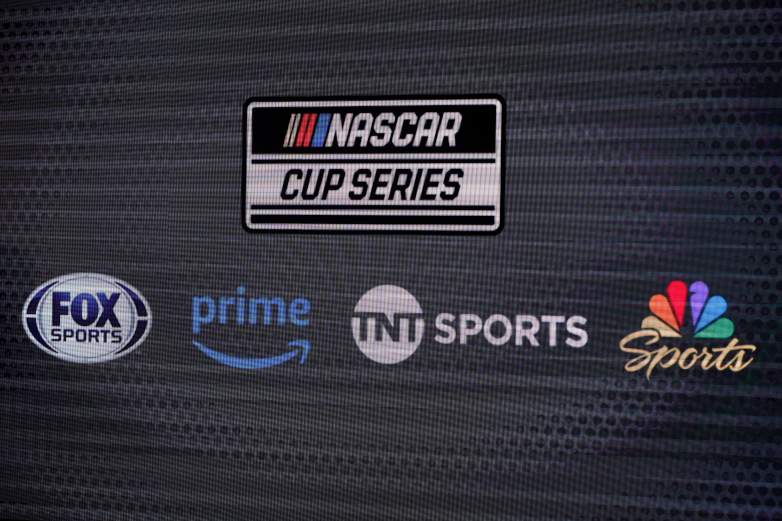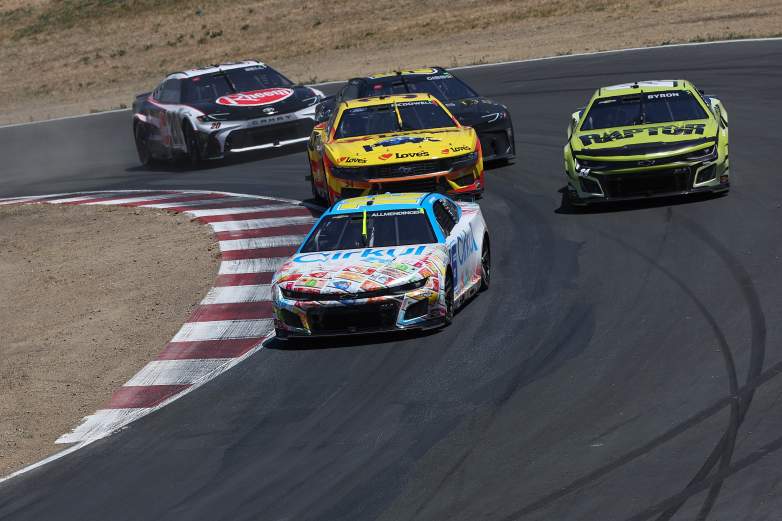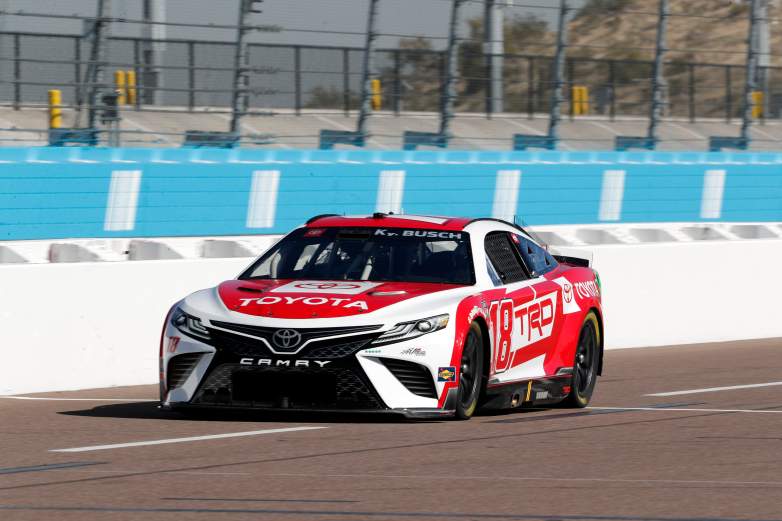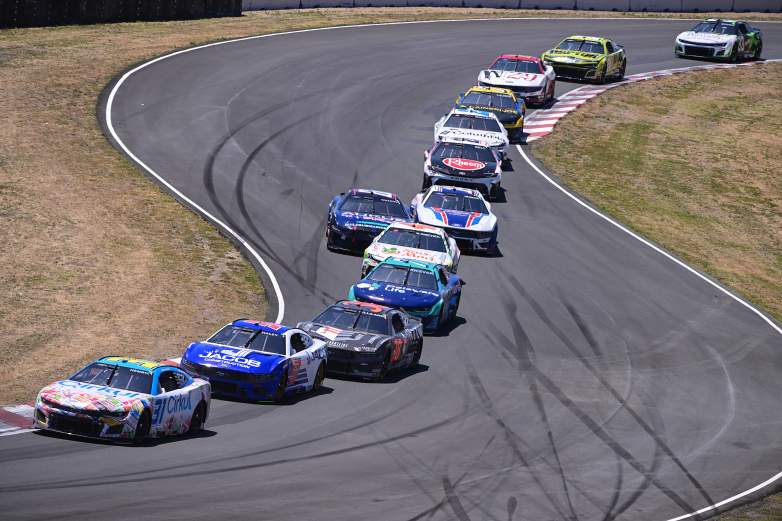
NASCAR Cup Series’ new media rights deal lays at the heart of the series’ ongoing struggle to come to a new charter agreement, with how the deal’s revenue will be distributed a chief concern.
On June 13, 2024, the NTT IndyCar Series announced their new, exclusive media rights deal with Fox Sports. IndyCar’s new deal is coming on the heels of NASCAR’s renewed media rights package, and right at the time of their contentious charter agreement negotiations.

GettyNascar Media Rights Deal, 2025
How NASCAR’s Media Rights Deal Works
NASCAR’s seven-year media rights deal is set to begin in 2025, with Fox Sports taking on the first 14 races (five on Fox, nine on FS1). Amazon will host the next five races on Prime Video, with Warner Bros. Discovery simulcasting the following five races on TNT and Max’s sports tier. NBC Sports will air the end of the season, with four races on NBC, and 10 on USA Network.
Think it’s not confusing enough? Amazon and Warner Bros. Discovery will also be broadcasting all Cup Series practice and qualifying sessions, regardless of whether their platforms will be hosting the main race or not. The first half of the season will be aired on Prime Video, and the second half on TruTV and Max.
Fox Sports has retained the media rights for the NASCAR Craftsman Truck Series. The CW Network will broadcast all NASCAR Xfinity Series races beginning in 2025.
The 2025 media agreement will net around $1.1 billion per year, which is a nearly 40% increase compared to NASCAR’s expiring package. The CW Network package itself is worth around $115 million per year.
It’s a lot of money, but how the broadcast revenue is distributed is complicated by the expiring charter agreement. Under the current deal, tracks receive 65% of TV revenue, 10% for NASCAR, and 25% for the teams.
Teams are pushing for a greater increase in broadcast revenue share, and there’s an important reason as to why; teams aren’t guaranteed a profit from simply racing.

GettyNASCAR Cup Series Toyota/Save Mart 350
How Nascar’s Business Model is Built
The traditional North American sports league sustains itself through multiple streams of revenue, such as ticket sales, and isn’t owned solely by a private equity firm. NASCAR is not only owned exclusively by the France family, but they own the majority of the tracks, too, leaving teams to depend almost entirely on sponsorship for revenue.
Some tracks are independent, such as the Portland International Raceway, while others are owned by Speedway Motorsports. In 2022, GlobalData released The Business of NASCAR 2023, a report by its intelligence center, which determined that 93 percent of the monetary value of the sport was in NASCAR and the tracks. Just 7 percent of the value was in the teams themselves.
The current deal amounts to around $8-10 million annually per car, but teams are searching for an increase to $16-18 million, and a general overhaul in how the broadcast revenue is distributed.
It’s in NASCAR’s best interest to increase teams’ value and ability to self-sustain financially through a greater share of the media rights deal, but it’s an aspect of the ongoing charter agreement negotiations that’s still undetermined.
As it stands, teams generate between 65 and 80 percent of their earnings through sponsorships, and they’ll have to rely even more so on that single income stream if NASCAR doesn’t increase their media rights allocation.

GettyKyle Busch drives for Joe Gibbs Racing
Teams Depend on Sponsorships For Money
In 2023, NASCAR’s largest sponsor was Xfinity, which invested $35 million. The overall annual sponsorship value of the 2023 season of $425.06 million, with 58 different deals contributing to that figure.
Sponsorship deals do expire, however, and the lost funds from a lost sponsor can have irreparable effects on a team. Joe Gibbs Racing was unable to re-sign Kyle Busch after their longtime sponsor Mars, Inc. announced that it wouldn’t return to the team, or sport, in 2023. This meant that JGR was searching for a sponsor (or a set of sponsors) who could fill that $20 million hole. After a potential agreement with a different company fell through, JGR began the season sponsor-less, and therefore unable to sign Busch to a new contract. A team having to let go of a multi-time champion driver because they can’t afford his contract without a sponsor is a harsh reality.
“There is no other pro sport where the signing of your top athlete is completely dependent on the decision of someone at a brand. Imagine if Aaron Rodgers of the (Green Bay) Packers had a contract held up because the stadium sponsor hadn’t made their decision on what they’re doing. That’s what we’re faced with as race teams. And, if I’m honest, we’ve almost become full-time fundraisers. We spend the majority of our time raising money, not to make money (but) to survive,” Said Joe Gibbs Racing President Dave Alpern.
It’s not just in 2023 that teams have struggled to balance their income and expenses; there’s quite a precedent for it. In 2022, Jeff Gordon, vice chairman of Hendrick Motorsports, revealed that the team, even having won the past two Cup championships at that time, would not make a profit that season.
“Where we’re currently at is not sustainable,” Gordon told NBC Sports.
And, RFK Racing President Steve Newmark acknowledged that the majority of teams expressed that “they continue to lose money in this economic model.”
“NASCAR acknowledges the challenges currently facing race teams. A key focus moving forward is an extension to the Charter agreement, one that will further increase revenue and help lower team expenses. Collectively, the goal is a strong, healthy sport, and we will accomplish that together,” Read a NASCAR statement released in 2022, the Friday following Gordon and Newmark’s comments, as reported by NBC Sports.

GettyLegacy Motor Club drivers Noah Gragson and Erik Jones
The Changing Sponsorship Model
It’s not enough to just rely on sponsorship moving forward; the face of NASCAR’s sponsorship model has changed over the last decade, and will only continue to shift as the sport progresses.
Sponsorships find value through promoting their service or product via social media, logo placement, liveries, at-track activations, and more in conjunction with the team itself. The team provides marketing and exposure, while the sponsors provide money to fund operating expenses.
Previous years saw sponsorships being purely monetary, made out in a check to a team, or NASCAR itself. Now, teams are finding that the brunt of their sponsorships is coming through technical alliances instead.
That’s been an increasing trend, but with the introduction of the Next Gen car in 2022, companies are seeing the value in promoting and testing their software and manufacturing in the vehicles themselves rather than on billboards.
“We’re making real dollar spends in these areas. It’s just like any other industry… we’ve embraced technology, we’re putting real dollars towards that,” Said Joey Cohen, VP of Race Operations at Legacy Motor Club Racing Team.
The Next Gen car does provide a fixed cost, but if teams are still constrained to funding the majority of their operation through sponsorships, teams will be under pressure to cut costs elsewhere. An example of what this could look like is sweeping layoffs at a team.

GettyNASCAR Cup Series
Will The Media Rights Deal Be Enough?
At the crux of it all lies NASCAR’s complicated revenue stream allocation. It’s clear that with rising costs across the grid, relying purely on sponsorships to eke out a minimal profit margin isn’t sustainable – not that it was long-term, anyway. But with the continued negotiations struggling to find a middle ground regarding increasing teams’ share of the media rights deal, what’s the solution? Can teams depend purely on broadcast coverage to boost their team’s income even without a greater share?
Other motorsport series have seen an increase in American viewership over the last year, with Formula 1 gaining a strong foothold in the North American market and IndyCar riding a viewership high into their new Fox Sports deal. NASCAR aims to increase its viewership substantially.
“Our goal was to secure long-term stability with an optimized mix of distribution platforms and innovative partners that would allow us to grow the sport while delivering our product to fans wherever they are – and we’ve achieved that today,” Said NASCAR President, Steve Phelps, on the new media rights deals.
The better the broadcast quality and the more accessible it is will grow fan engagement and viewership, create new casual fans, and entice fans to attend races. With the coverage split between four different providers, there’s equal opportunity for NASCAR to find increased viewership and growth in the variety of audiences, and for races to fall through the cracks.
The better the cross-promotion of the races and general content between traditional media and social media (such as between the FOX Sports official Instagram and the Fox Sports television broadcast), the stronger the possibility of NASCAR seeing real benefits from the variety of coverage. On the flip side, it will be interesting to see how Amazon or Warner Bros. Discovery choose to promote their five NASCAR races – if it will be a year-long build-up (leading to greater social media engagement and growth potential) or if it will be a blip on the radar for those five weeks.
At the end of the day, increasing costs are unavoidable, and a complicated sponsorship landscape has left teams in dire need of greater revenue streams going forward. An increased share of broadcast revenue will allow them more wiggle room in their budget. The extra dollars means that where they used to rely heavily on sponsorship revenue to pay overhead costs, that money can then be spent on innovation and competitive advantage.
Team owners are intent on ensuring their teams’ financial viability, but without a provision in the new charter agreement regarding an increase in teams’ allocation of the media rights deal revenue, it’s clear that teams will only continue to struggle to turn a profit if the status quo continues.
Comments
Media Rights Revenue at Center of NASCAR Teams’ Struggle For Money